With so many varieties available in such a wild range of designs, colors, and patterns, it’s no wonder many people like to domesticate fish. These loveable creatures can make marvelous companions, bring smiles to your children, friends, and guests, and add remarkable color to your living area. Various types of tropical fish are typically the most sought-after.
However, many species of fish can be incredibly challenging to care for. Balancing complex diets, optimal water temperatures, pH levels, etc., can be time-consuming, and if a mistake is made, it can also have devastating and deadly consequences. For first-time fish owners, it is always best to go with a low-maintenance species. Of course, picking out the right fish for your family can be easier said than done. To make it simpler, we have compiled the 15 easiest pet fish to take care of for new owners.
Goldfish (Carassius auratus)
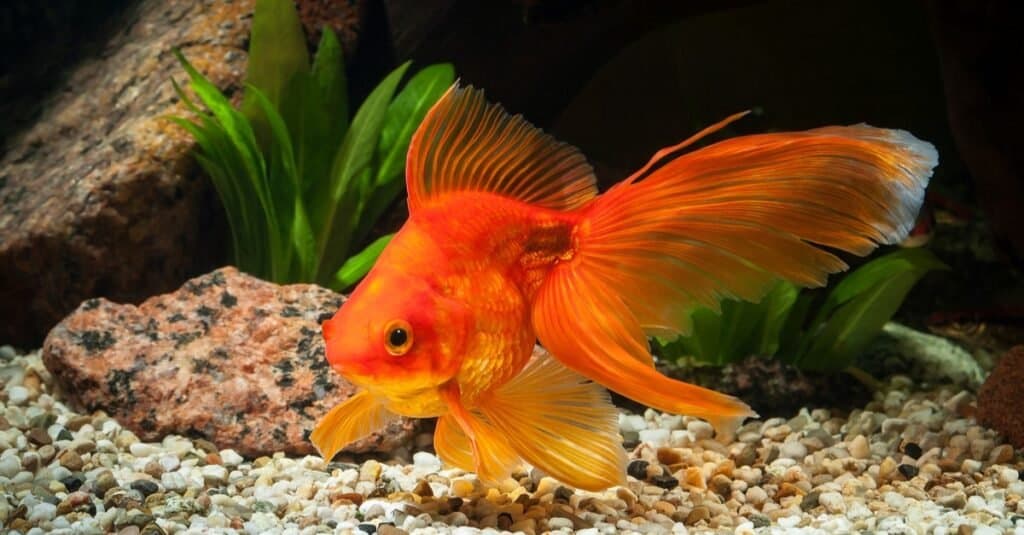
Goldfish are the most common fish for first-time owners.
©dien/Shutterstock.com
The goldfish is a standard pet in many homes. For beginners, starting with a common variety like a comet or shubunkin is highly recommended. This is because there are numerous types of goldfish, and many varieties can be difficult to care for. Comet goldfish are long-body goldfish that are typically orange, white, black, or gold. They can grow to about 14 inches but start very small and overall low-maintenance.
The most significant requirement is space to grow. It is recommended for new fish owners to start their goldfish in a 20-gallon tank minimum. As your fish grows, they may require a larger tank. A good filter is also vital for your goldfish, as they are notoriously known to be less-than-great feed converters. They often produce more waste than many other types of fish, so keeping a clean environment will keep them happy and thriving.
Bloodfin Tetra (Aphyocharax anisitsi)
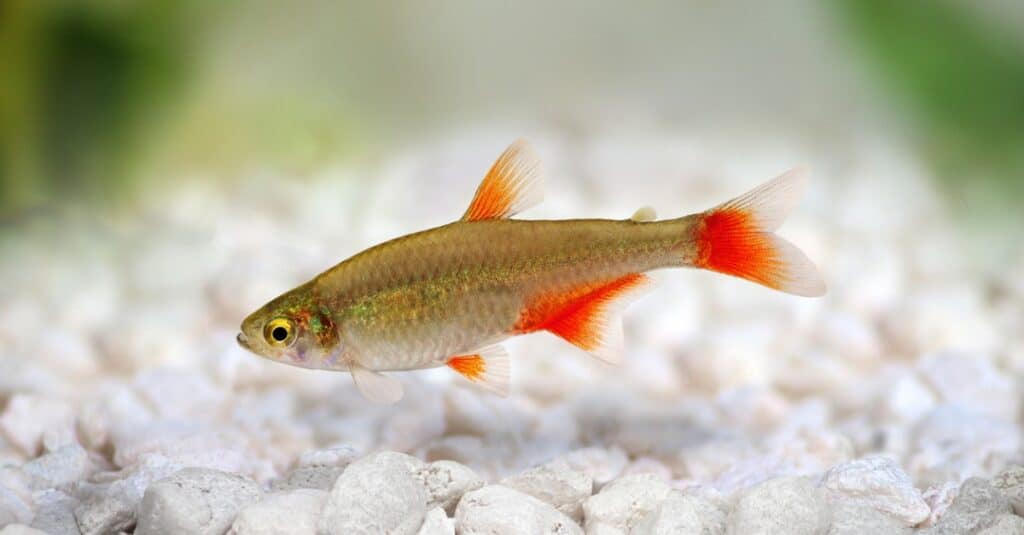
A bloodfin tetra swimming in a spacious aquarium.
©iStock.com/Mirko_Rosenau
Silver in color with blood-red tails, bloodfin tetras are highly social, small, and easy to maintain. These little guys can live up to a decade with little maintenance and adjust to water temperature and pH level changes reasonably well. So long as temperatures range between about 64 and 82 degrees, they require little more than food and a filter to thrive. Hey, we are cold-blooded, so heaters are not typically necessary. Additionally, swordtails are not picky eaters, which makes caring for them even easier for novice fish owners.
Betta Fish (Betta splendens)

A betta fish showing off its beautiful colors and delicate fins.
©MR.AUKID PHUMSIRICHAT/Shutterstock.com
Starting with a betta fish is recommended. However, it is first and foremost important to know that, like all pet fish, bettas will live much happier, longer lives with more room and a little extra attention. That said, bettas require little more than food, a filter, and a heater. A larger tank of at least five gallons is ideal not only to give your betta some space but also because the more water, the easier the heater can maintain a steady temperature. As tropical fish, bettas like their water between 78 and 82 degrees Fahrenheit.
One of the most beautiful features of bettas is their long, elegant fins. While they are gorgeous, it is also essential to know they are delicate. This means it is crucial to use an appropriate size filter and keep it low so the water flow doesn’t knock them around. Also, adding only soft or rounded décor inside their tank will keep their fine fins safe from tearing.
Unfortunately, male bettas tend to fight with each other, so it’s generally safest to only keep one male at a time. If your aquarium is large enough, females can live together in harmony. Lastly, only add betta-specific décor as well as beta-specific food. Concerning food, beta-specific pellets are the best option as they come in the right size for their mouths and are packed with the required nutrients. Never overfeed them. Bettas have tiny stomachs and should never be fed more than twice daily or offered more food than they can consume in approximately three minutes.
White Cloud Minnow (Tanichthys albonubes)

A shiny white cloud minnow swimming alone.
©Besjunior/Shutterstock.com
As long as they are kept in groups of at least five, white cloud minnows are incredibly peaceful community fish. It is also recommended to keep them in a tank with other smaller fish to encourage their social ability further. While a 20-gallon tank or larger is best, new owners can house their cloud white minnows in a ten-gallon tank minimum. They will thrive at a temperature between 60 and 72 degrees with a pH level of 6.0 to 8.0. White cloud minnows eat various foods, including flakes and pellets, live, frozen, or freeze-dried worms, brine shrimp, and mosquito larvae.
Zebrafish (Danio rerio)

Zebrafish live, feed, and travel in schools.
©Oregon State University / Creative Commons – License
These adorable little fish are known for their distinct colors and horizontal zebra-like stripes, but they are also one of the most low-maintenance fish, perfect for beginners. However, keeping one alone is not a good idea. Zebrafish are school fish, so you will want to keep several together. Fortunately, they only grow to about two inches long, so a five or ten-gallon tank should provide plenty of space.
Regarding temperature, zebrafish are different than most other tropical fish. These tiny companions don’t require extremely warm temps, so keeping their water around 70 degrees is ideal. A small heater is recommended during winter months or on otherwise colder nights. Thanks to fluorescent jellyfish protein and a little genetic engineering, zebrafish come in beautiful day-glow colors that are highly pronounced under blue LED lights, making them extra attractive to younger first-time owners.
Angelfish (Pterophyllum scalare)
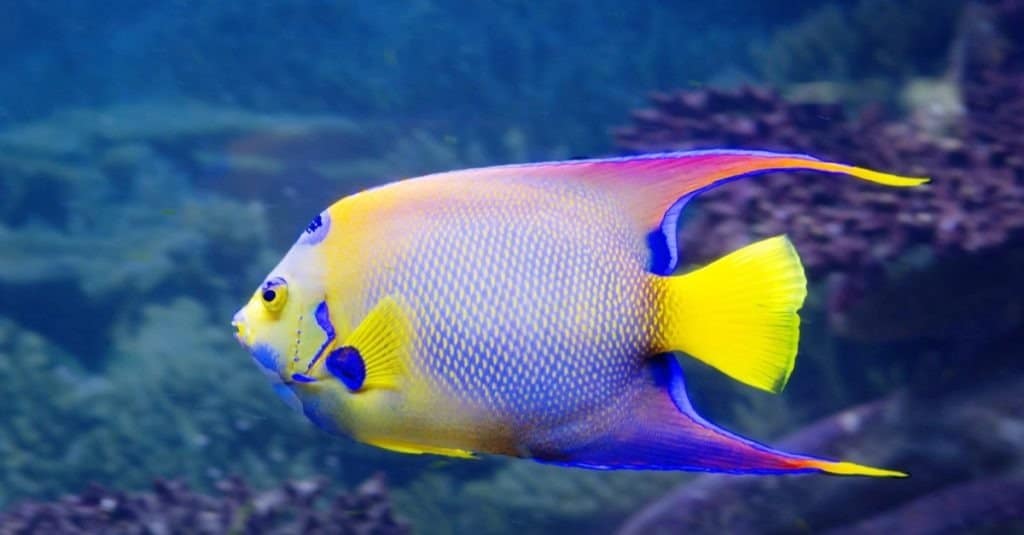
Angelfish come with a dazzling array of colors and patterns.
©Galina Savina/Shutterstock.com
Although some people might be under the impression that angelfish are challenging to care for, the truth is the polar opposite. While they require a larger tank and can grow to up to six inches in length, they require very little maintenance. Angelfish are omnivores, which makes feeding them easy, albeit not good companions for other, smaller fish. They tend to be a bit aggressive but will eat nearly any food they can find, including live or dead plants or meat. They are resilient to changes in water conditions, making them simple fish for beginners.
Neon Tetras (Paracheirodon innesi)
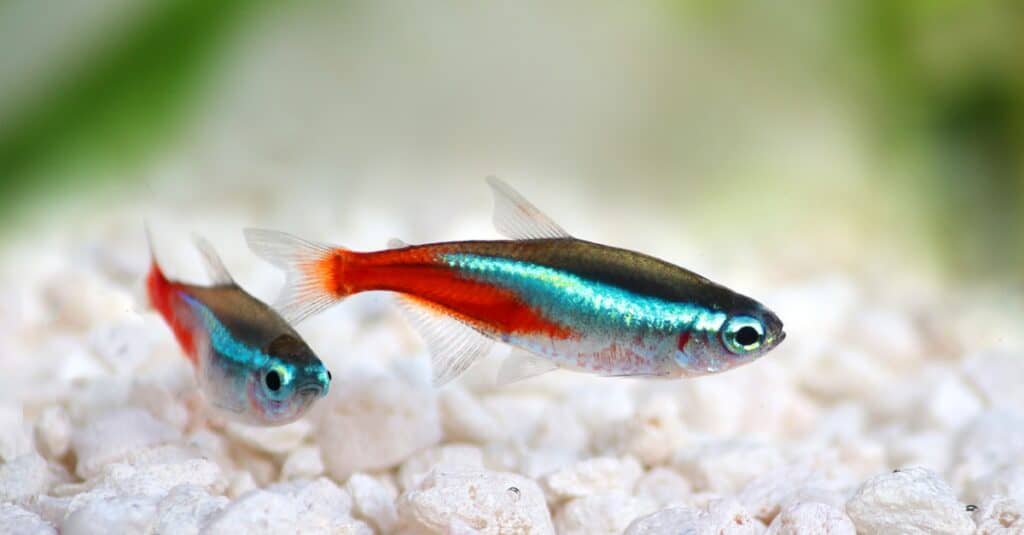
Neon tetras are some of the most brightly colored of the tetra species.
©iStock.com/Mirko_Rosenau
With vibrant streaks of red and blue, neon tetras make for a lovely sight by themselves or as a colorful addition to an existing community tank. These fish are perfect for beginners as they require little maintenance and are typically easygoing. Due to their tiny size, they have minimal impact on water quality and only grow to about one and a half inches in length. It is crucial to start with at least three to five neon tetras since they are friendly fish that flourish in schools.
Swordtail (Xiphophorus helleri)
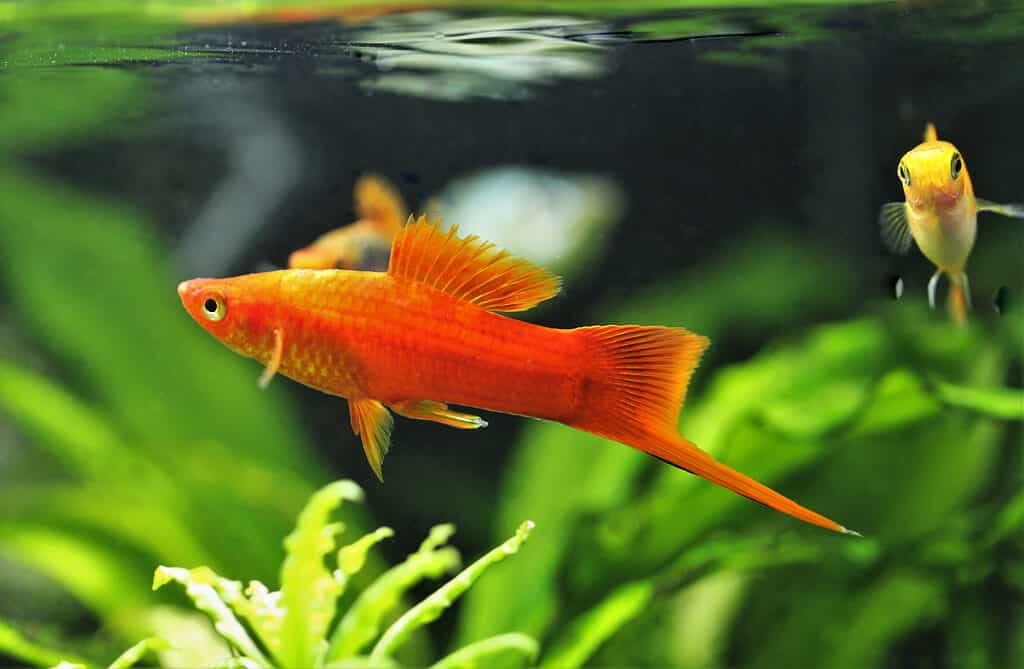
All swordtails tend to hang out near the surface of the water where it’s warmer.
©Arunee Rodloy/Shutterstock.com
Swordtails are known for being extraordinarily peaceful and pleasant fish. They are perfect for a community tank as they will not attack other fish. With minimal care, swordtails can live long, happy lives as long as they have space and a heater. The fact they can survive in various water temperatures and conditions makes them one of the best fish for first-time owners.
Harlequin Rasbora (Trigonostigma heteromorpha)

The harlequin rasbora shows off its signature tail markings.
©nadiia_oborska/Shutterstock.com
The hands-down easiest species of rasboras to care for is the harlequin. These gorgeous little fish feature an unmistakable black triangular marking along their tails, complementing their pinkish bodies and orange fins. Also known as schooling fish, they require at least a ten-gallon tank for six individual fish. The water temperature should be kept around 72 degrees with a 7.2 pH level. Besides these few specifics, harlequin rasboras are some of the easiest fish to maintain.
Guppy (Poecilia reticulate)
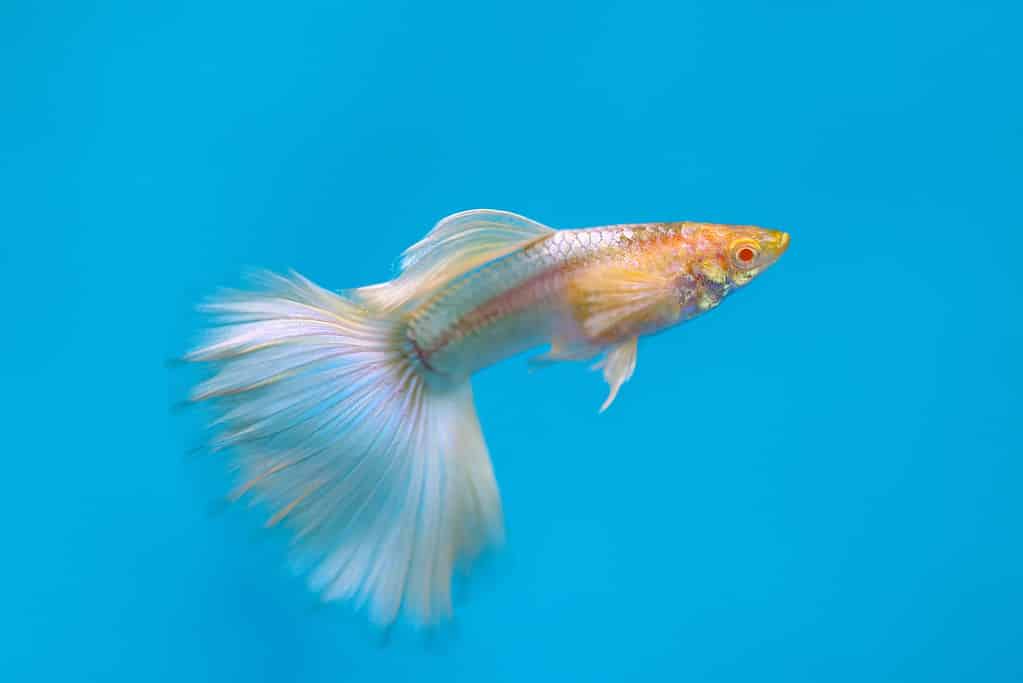
An albino guppy thrives in open spaces.
©IamTK/Shutterstock.com
For the freshwater aquarium, guppies are renowned for being one of the most popular for first-time owners. They come in a wide variety of colors and are extremely easy to care for. Guppies are known to get along well with other similar species but also being quite shy at first. It is best to keep your guppy in a ten-gallon tank or larger with plenty of hiding places. A relatively flexible temperature of about 68 to 78 degrees and a pH of 6.5 to 8.0 is best for them. One minor drawback is that guppies prefer being in groups but also breed often. So, watch out for babies and have a plan for them if you decide to start your fish-owning journey with guppies.
Cory Catfish (Corydoras)
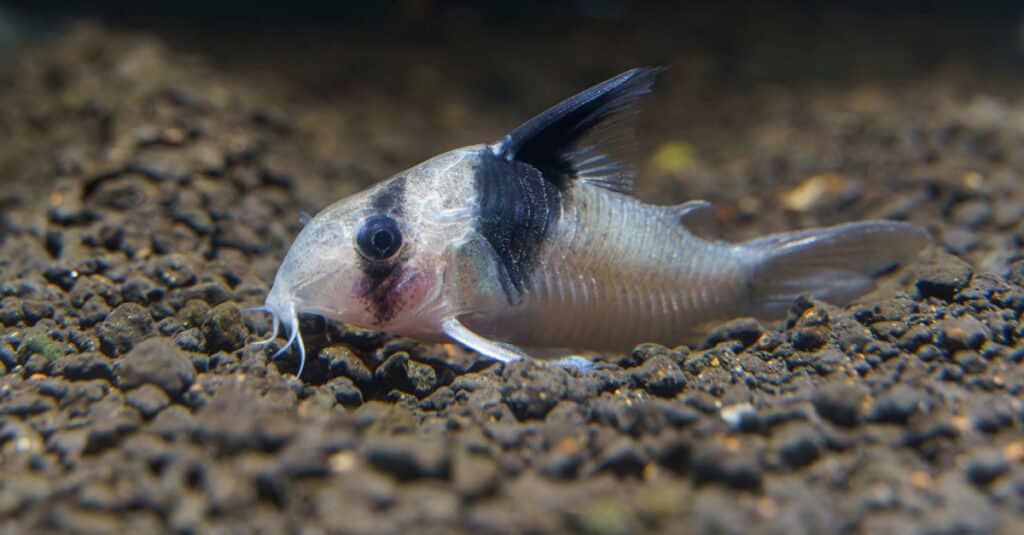
A
panda
cory searches for food at the bottom of its tank.
©chonlasub woravichan/Shutterstock.com
There are several species of Corydoras, including the panda cory, albino cory, and bronze cory. These types are all bottom feeders and very simple to manage for the beginner. They will enjoy spending their time foraging around the floor of your aquarium, which should be kept between approximately 72 and 82 degrees. These types of catfish should be given a tank no smaller than 20 gallons with a pH level of 6.5 to 7.8. Cory catfish are not picky eaters and require little maintenance beyond standard care.
Black Molly (Poecilia sphenops)
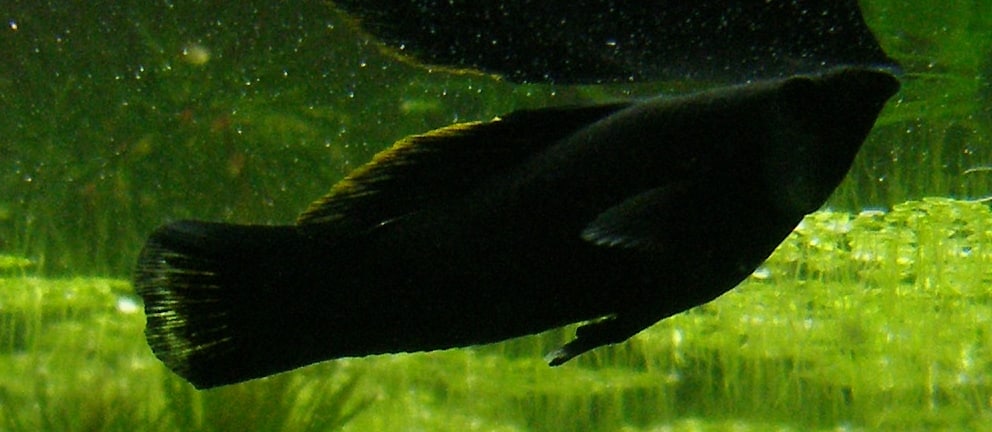
A black molly reaches the surface of the water.
©No machine-readable author provided. Darkmax assumed (based on copyright claims)., CC BY-SA 3.0 <http://creativecommons.org/licenses/by-sa/3.0/>, via Wikimedia Commons – License
Ideal for a community tank, black mollies are a fairly peaceful species. These fish rarely ever attack other fish, so there is generally no issue keeping them in a community tank. They are resilient when it comes to pH levels. However, they do prefer a temperature ranging from 70 to 82 degrees. You will likely need a heater and a filter, but not much else is required to care for them. The black molly has the ability to adapt to salt water or fresh water, which means they can generally do well in just about any tank. They usually eat simple flakes or pellets, so feeding is neither an issue. For the first-time fish owner, the black molly is an ideal option.
Kuhli Loach (Pangio kuhlii)
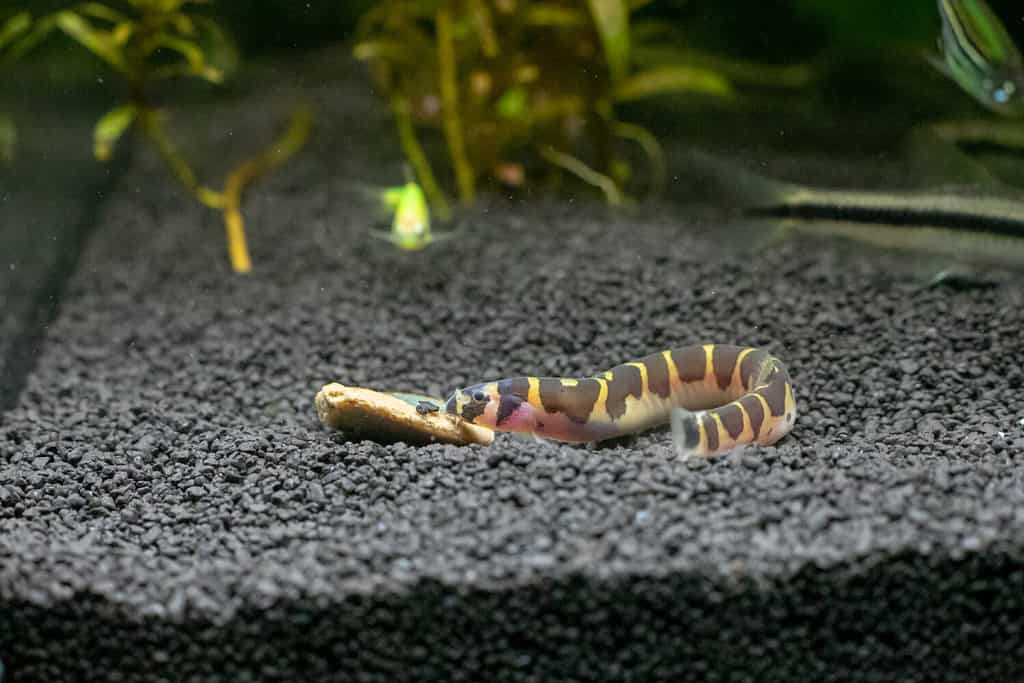
A kuhli loach feeding at the bottom of its tank.
©Olga Chezhina/Shutterstock.com
The kuhli loach is one of the most recognizable small fish due to its eel-like appearance. These guys grow up to around four inches in length, so they require a larger tank. However, they are extremely friendly and peaceful, rarely showing aggression toward other fish. Keeping them in a community tank is hardly an issue as they frequently hide, but keep in mind that they are omnivores. Still, these fish tend to prefer simple foods such as blood worms and daphnia. The kuhli loach is known to enjoy leftover, uneaten food, keeping the substrate in your tank clean.
As for any maintenance, you will need a heater to keep your kuhli loach warm. These fish like the temperature of the water between 75 and 86 degrees. They also require a relatively delicate pH level of 6.0 to 6.5. However, as long as the water in their tank is not too acidic, they will be easy to maintain fish for a long time.
Easiest Pet Fish to Take Care of For New Owners
| Species | |
|---|---|
| 1 | Goldfish (Carassius auratus) |
| 2 | Bloodfin Tetra (Aphyocharax anisitsi) |
| 3 | Betta Fish (Betta splendens) |
| 4 | White Cloud Minnow (Tanichthys albonubes) |
| 5 | Zebrafish (Danio rerio) |
| 6 | Angelfish (Pterophyllum scalare) |
| 7 | Neon Tetras (Paracheirodon innesi) |
| 8 | Swordtail (Xiphophorus helleri) |
| 9 | Harlequin Rasbora (Trigonostigma heteromorpha) |
| 10 | Guppy (Poecilia reticulate) |
| 11 | Cory Catfish (Corydoras) |
| 12 | Black Molly (Poecilia sphenops) |
| 13 | Kuhli Loach (Pangio kuhlii) |
The photo featured at the top of this post is © iStock.com/niuniu
Thank you for reading! Have some feedback for us? Contact the AZ Animals editorial team.






